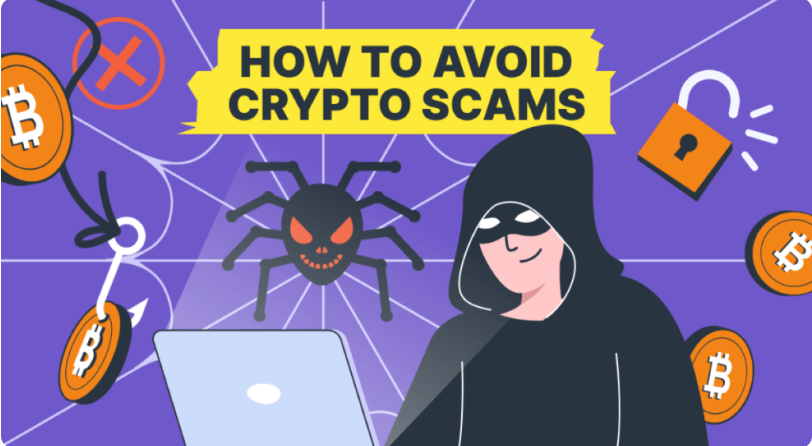Avoiding Scams: How to Stay Safe in Crypto Investing
The world of cryptocurrency offers exciting opportunities but it also comes with real risks, especially for new investors. With millions of dollars lost to scams each year, knowing how to spot red flags and protect yourself is just as important as choosing the right coin to buy.
In this post, we’ll walk you through the most common types of crypto scams, how to recognize them, and practical tips to keep your crypto assets safe.
Common Types of Crypto Scams
1. Phishing Attacks
Scammers create fake websites, emails, or social media messages that look like trusted platforms (e.g., wallets or exchanges) to steal your login info or private keys.
-
🔴 Red flag: Unusual links, misspellings, or urgent “security alerts”
-
✅ Stay safe: Always check the URL; never enter your seed phrase online
2. Fake Airdrops or Giveaways
Scammers promise free crypto in exchange for your personal details or a small “verification” payment.
-
🔴 Red flag: “Send 0.1 ETH and get 1 ETH back” messages
-
✅ Stay safe: Real giveaways don’t ask you to send funds first
3. Rug Pulls and Scam Tokens
Developers hype a new crypto project, get investors to buy in, then disappear with the funds. Common in low-market-cap coins or unverified DeFi tokens.
-
🔴 Red flag: Anonymous team, no whitepaper, unrealistic promises
-
✅ Stay safe: Research thoroughly, use trusted platforms like CoinMarketCap or CoinGecko
4. Pump-and-Dump Schemes
Groups artificially inflate the price of a low-volume coin, attracting unsuspecting buyers — then sell off, causing the price to crash.
-
🔴 Red flag: Sudden price spikes with no real news or development
-
✅ Stay safe: Avoid FOMO; do your own research before jumping in
5. Impersonation Scams
Scammers pose as influencers, support agents, or well-known crypto personalities to solicit funds or sensitive info.
-
🔴 Red flag: DMs from “official” accounts offering investment tips or support
-
✅ Stay safe: No legitimate support team will DM you first; always verify from official websites
6. Ponzi or Pyramid Schemes
These offer guaranteed returns and require you to recruit others to earn rewards. Profits are paid using funds from new investors.
-
🔴 Red flag: “Earn 2% daily, guaranteed!” or referral-heavy structures
-
✅ Stay safe: If it sounds too good to be true, it probably is
🔐 How to Protect Yourself in Crypto
✅ 1. Use Trusted Platforms Only
Stick to reputable exchanges (like Binance, Coinbase, Kraken) and wallets (like MetaMask, Trust Wallet, or Ledger).
✅ 2. Enable Two-Factor Authentication (2FA)
Add an extra layer of security to your accounts using apps like Google Authenticator or Authy.
✅ 3. Never Share Your Private Keys or Seed Phrase
No legit service will ever ask for these. Keep them offline and stored securely.
✅ 4. Double-Check URLs and Apps
Bookmark your exchange or wallet site, and download apps only from official app stores. Watch for lookalike sites.
✅ 5. Do Your Own Research (DYOR)
Before investing, ask:
-
Who is behind the project?
-
What problem does it solve?
-
Is there a whitepaper and roadmap?
-
Is the token listed on trusted platforms?
✅ 6. Use Hardware Wallets for Long-Term Storage
For large or long-term holdings, use a cold wallet like Ledger Nano X or Trezor to keep your crypto offline and safe from hackers.
Bonus Tips for Staying Safe: Avoiding Scams: How to Stay Safe in Crypto Investing
-
Don’t trust screenshots or testimonials they’re easy to fake
-
Avoid clicking links in DMs, Telegram, or unknown emails
-
Use blockchain explorers (like Etherscan or BSCScan) to verify token contracts
-
Start small with new projects to limit your risk
-
Keep learning the more informed you are, the harder you are to scam
Final Thoughts on Avoiding Scams: How to Stay Safe in Crypto Investing
The crypto space is full of innovation, but it’s also an open field for fraudsters. Being cautious, skeptical, and security-conscious will help you protect your investments and your peace of mind.
Remember: If it looks too good to be true, it usually is.
Stay smart, stay alert, and stay safe.


